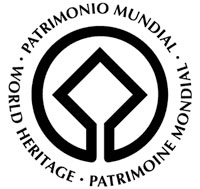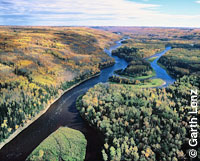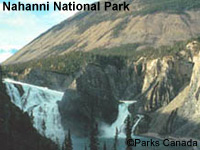
Manitoba World Heritage Site
World Heritage Site
What is a World Heritage Site?World Heritage Sites are places of natural and/or cultural significance that are considered to be of "outstanding universal value". Achieving inscription on the 'World Heritage List' involves a nomination and evaluation process that can take several years.Natural Heritage Sites are outstanding examples representing:
 World Heritage Sites (WHS) came into existence as a result of the International Convention Concerning the Protection of the World Cultural and Natural Heritage (the Convention), which was adopted by the General Conference of UNESCO (United Nations Educational, Scientific and Cultural Organization) in 1972. The primary goal of the Convention is to "identify and protect the world's natural and cultural heritage considered to be of'outstanding universal value'" The World Heritage Committee is the main body in charge of the implementation of the Convention; it is supported by the UNESCO World Heritage Centre, which acts as the secretariat for the Convention. The World Conservation Union (IUCN) also provides technical services to the UNESCO, regarding WHS.
World Heritage Sites (WHS) came into existence as a result of the International Convention Concerning the Protection of the World Cultural and Natural Heritage (the Convention), which was adopted by the General Conference of UNESCO (United Nations Educational, Scientific and Cultural Organization) in 1972. The primary goal of the Convention is to "identify and protect the world's natural and cultural heritage considered to be of'outstanding universal value'" The World Heritage Committee is the main body in charge of the implementation of the Convention; it is supported by the UNESCO World Heritage Centre, which acts as the secretariat for the Convention. The World Conservation Union (IUCN) also provides technical services to the UNESCO, regarding WHS.View the UNESCO World Heritage sites in panography - 360 degree imaging As World Heritage Sites of universal value and significance, these special places belong to all global citizens, regardless of geographic location. Both the home country and the rest of the world hold an obligation to maintain and protect these sites for current and future generations. Sources: World Heritage Centre, IUCN, Operational Guidelines for the Implementation of the World Heritage Convention
View the Convention Concerning the Protection of the World Cultural and Natural Heritage The World Heritage List currently consists of 830 sites, which include 644 cultural, 162 natural and 24 mixed areas in 138 States Parties. Canada's World Heritage Sites Within Canada, there are 14 World Heritage Sites:
Source: World Heritage List
View The Altas of Canada's Map of Canadian World Heritage SitesView Canada's Tentative List for World Heritage Sites Boreal Forest World Heritage Sites Boreal forest ecozone is under represented on the World Heritage List in relation to their global total area. Of the natural sites included on the List, twelve are located in the boreal ecozone. These sites are located in four countries (Russia, Sweden, Canada and the USA).
Boreal forest ecozone is under represented on the World Heritage List in relation to their global total area. Of the natural sites included on the List, twelve are located in the boreal ecozone. These sites are located in four countries (Russia, Sweden, Canada and the USA).The boreal ecozone contains several features of outstanding universal value such as unique forest and wetlands ecosystems and species assemblages, habitats for rare and endangered species, the world's largest intact frontier forests, geologically and geomorphologically unique territories, and areas of superlative natural beauty. The workshop also recognized another feature of outstanding value in the unique cultural heritage representing the diverse lifestyles of several indigenous peoples and ethnic sub-groups that have inhabited the boreal forest regions for thousands of years and maintain their traditional lifestyles. The boreal forests and associated wetlands are also globally important freshwater resources and carbon sinks for the world.
Furthermore, boreal forests and the cultural heritages supported by this ecozone are currently under threat due to extensive industrial activities and climate change. As a result, the Proceedings of the World Heritage Boreal Workshop (October 2003) have been added to the list of under-represented themes on the World Heritage List, which guides the World Heritage Committee when evaluating new WHS nominations. Sources: Proceedings of the World Heritage Boreal Zone Workshop (June 2004), The St. Petersburg Statement, World Heritage Global Strategy
WHS Inscription ProcessWorld Heritage Site (WHS) nominations can be made by countries that are signatory to the Convention Concerning the Protection of the World Cultural and Natural Heritage (the Convention). Nominations are evaluated by two independent Advisory Bodies - ICOMOS (the International Council on Monuments and Sites) for cultural properties and IUCN (World Conservation Union) for natural properties. ICOMOS and IUCN work together for the evaluation of mixed (natural and cultural) properties, while IUCN also provides input, where relevant, to the ICOMOS evaluation of cultural landscapes.The evaluation is a rigorous, year-long process, after which the IUCN provides recommendations to the UNESCO intergovernmental World Heritage Committee. The Committee then decides which sites to inscribe on the World Heritage List. In addition, 
The IUCN evaluation process includes a field mission to each nominated site to meet the authorities and stakeholders, and to assess the management and integrity of the site. IUCN also seeks input from international experts knowledgeable about the sites or the natural values they represent. These reviewers carry out desk reviews of each nomination and provide views on their global significance, management and integrity.
Source: IUCN
The Nomination File, which is evaluated by the Advisory Bodies and the World Heritage Committee (see Box: Steps in the WHS Nomination Process below) must, for example, include the following information, as per Section III of the Operational Guidelines for the Implementation of the World Heritage Convention:
View the World Heritage Committee's Criteria for the assessment of outstanding universal value  Download the Operational Guidelines for the Implementation of the World Heritage Convention (PDF) Download the Operational Guidelines for the Implementation of the World Heritage Convention (PDF) |
Steps in WHS Nomination Process
Source: Adapted from World Heritage Centre |
 2002-2014
2002-2014

